Experimental process methodology
All rankings can be modified until the campaing end.
All the examples on this page have been positioned randomly, please disregard them for your rankings.
Introduction
The experiment is divided into 5 steps. The first three steps are ordered and can only be started once the previous step has been completed. The next two steps are additional. They are not decisive in establishing the reference ranking, but they allow an integration of biodiversity gains into their reality, and to make the practices interdependent and integrated into an environment.
The first three stages are mandatory to take a participation into account. They allow us to build, step by step, a participant's ranking. A socio-ecosystem reference ranking is calculated by the robustness of the consensus between the individual rankings.
The two additional steps allow to relax the independence hypotheses of inbetween practices' gains and sites environments conditions with the practices. In one, we categorize the relationships between practices (two by two) from highly synergistic to highly redundant (5 categories). In the other, we ask to categorize the effect of a gradient (humidity / acidity / landscape openness) on the realization of the practice's gain, from highly amplified to highly reduced (5 categories).
The additional steps, although not mandatory, have a strong added value, as they enable the practice to be inscribed in the reality of its realization. Furthermore, those assessments are impossible to carry out in-vivo, and can only be approximated in this exercise type (expert opinion / semi-quantitative).
Evaluated items :
For a given socio-ecosystem, in a given climate, for a given biome and for a given use
-
a list of 15 to 20 practices
-
3 at 6 levels (cumulative) per practice
-
3 site conditions
-
+ the various combinations of these elements
Course :
Mandatory course :
Presentation
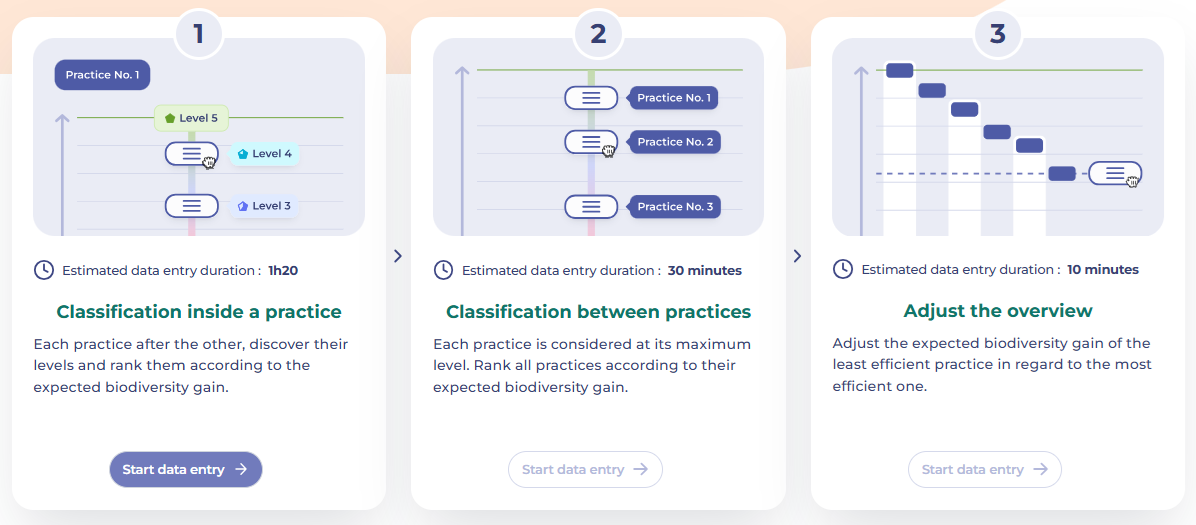
Exercise 1 : Classification inside a practice
Each practice after the other, discover their levels and rank them according to the expected biodiversity gain.
Position the practice's levels on the expected biodiversity gain scale. The gap between levels illustrates the relative difference between these biodiversity gains.
Exercise screen display
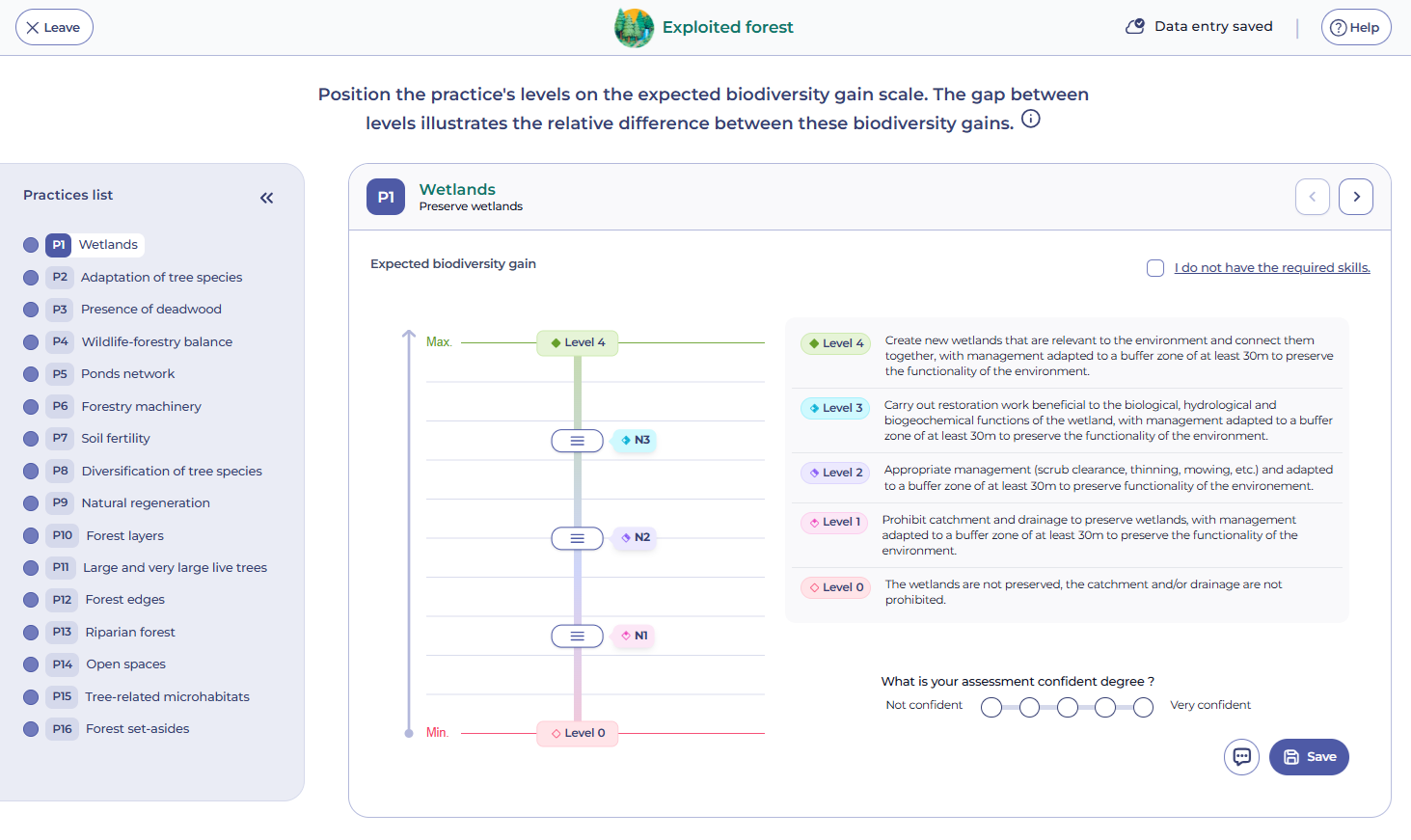
On the left, the practices list with a different order of display from one expert to another. On the right, the under study practices' levels content. The under study practice is the one selected in the left menu and whose title can be found at the top of the evaluation window. In the center, the scale on which the exercise must be performed.
You can find the practices taxonomies contents in the PDF documents downloadable on the program page.
Initial positioning
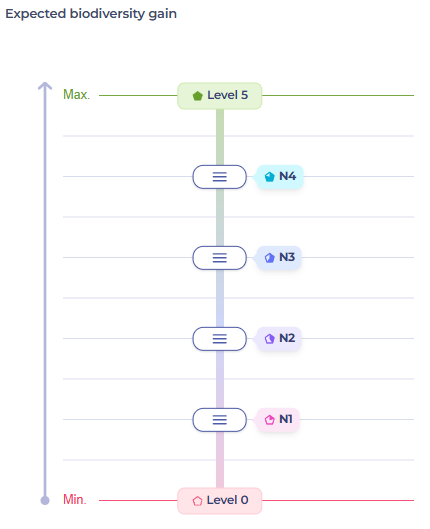
Possible final positioning
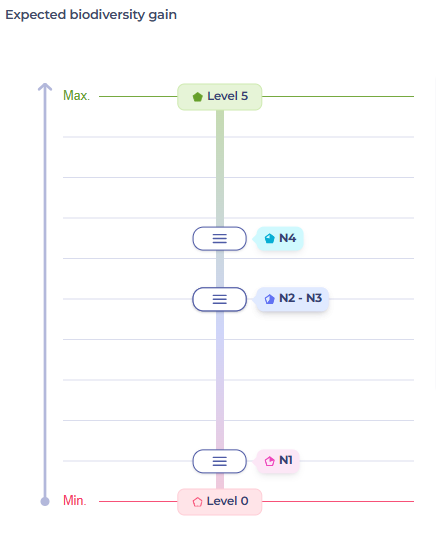
In the first exercise, practices are presented one after the other. The level 0 and the maximum level are fixed. The intermediate levels are presented with homogeneous gaps.
Starting with the content of the practices, one after the other, allows you to familiarize yourself with the specificities of the items that will be evaluated throughout the experimental journey.
Participants are asked to reposition the levels so that the gaps represent the relative difference between the expected biodiversity gains. As the requirements described in the levels are not proportional from one level to another, a homogeneous gap in expected biodiversity gain between each level would not be coherent.
Experts can indicate that they are unable to evaluate a practice, in which case it is eliminated from their list of items to be evaluated.
(check “I do not have the required skills.”)
Once a practice has been evaluated, experts indicates their levels of confidence in their positioning. These confidence levels allow us to capture some of the intra-assessor variance. They also encourage experts to take risks by responding to practices that are less mastered.
Exercise 2 : Classification between practices
Each practice is considered at its maximum level. Rank all practices according to their expected biodiversity gain.
Position on or more practices on the scale's endpoints and space out the remaining practices making the gaps proportional to the expected biodiversity gain difference.
Exercise screen display
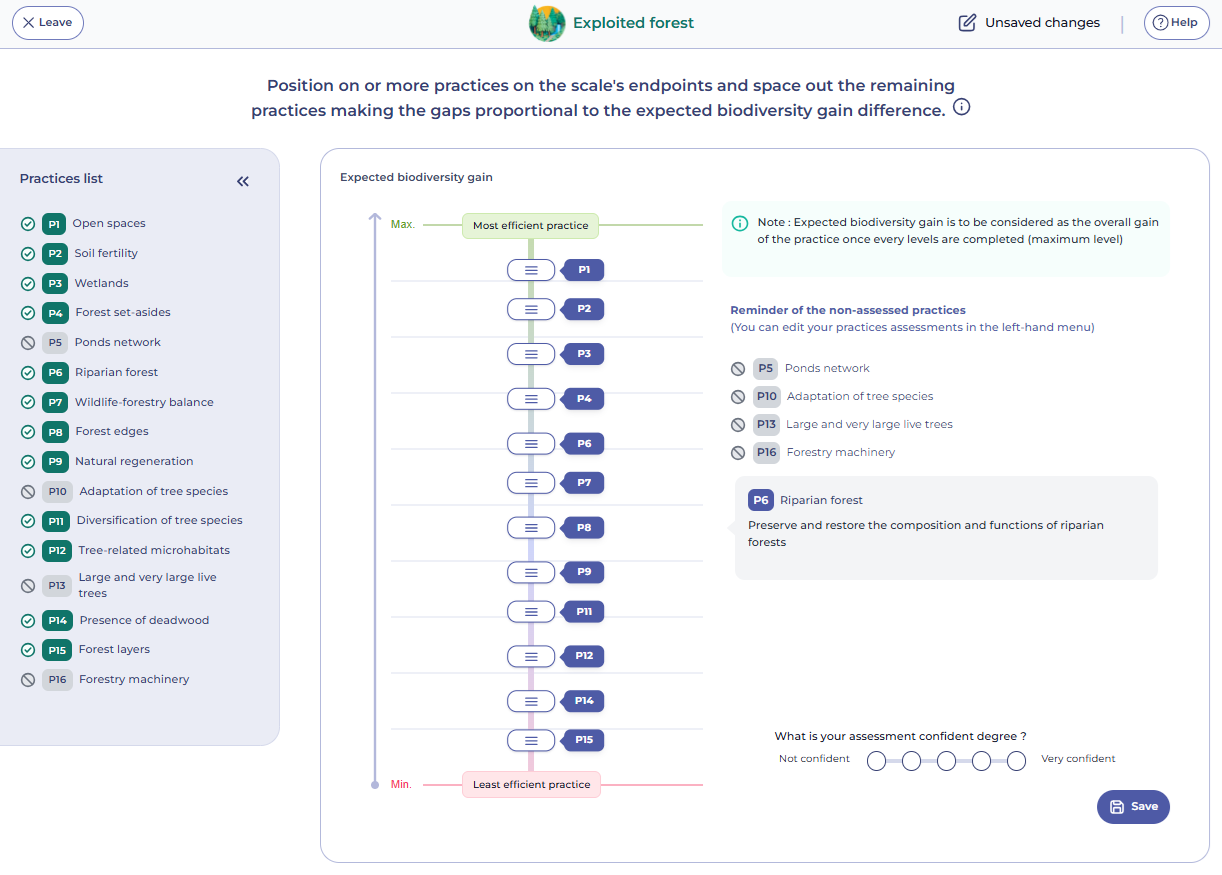
On the left, the menu of practices and their status (evaluated / eliminated from the item set). Once a practice is clicked, the values entered in step 1 can be modified. On the right, the list of practices eliminated from the set and a highlight of the practice currently being positioned. In the center, the scale on which the exercise is to be done.
Initial positioning
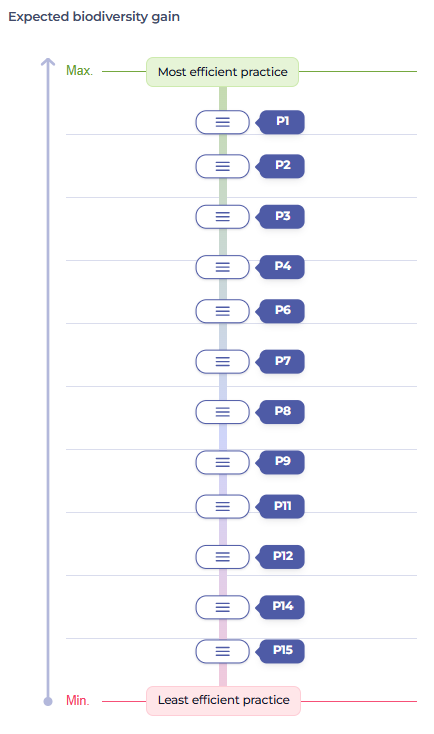
Possible final positioning

The second exercise works in a similar way to the first. The differences are that one must set their own endpoints and that it's now practices that are compared with between themselves (inter) and no longer between the levels one practice (intra).
Participants are asked to reposition the practices so that the gaps represent the relative difference between the expected biodiversity gains. Initially, the practices are positioned with homogeneous gaps and according to the evaluator's order of presentation (different from one person to another).
Once the assessment has been made, the expert indicates their level of confidence in the positioning. These confidence levels allow us to capture some of the intra-assessor variance.
Exercise 3 : Adjust the overview
This is an overview of your previous assessments. Adjust the biodiversity gain of the least efficient practice relatively to the most efficient one according to the expectef biodiversity gain scale.
Exercise screen display
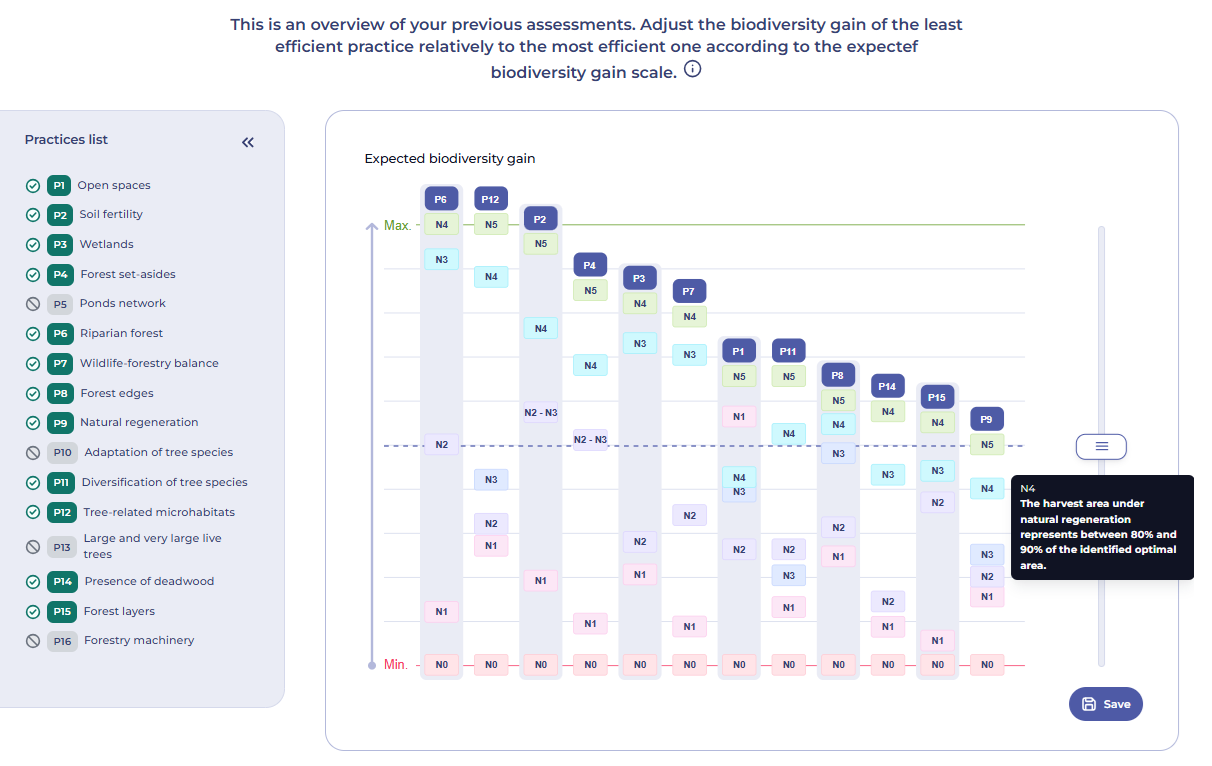
This time the exercise is to adjust the relative height of the least effective practice compared to the most effective one (the least effective is arbitrarily positioned at 50% of the height of the most effective practice at the beginning of the exercise). When the cursor is moved, all the intermediate positions of the levels and practices are recalculated. This calculation matches the relative gaps entered in previous exercises with the new relative height of the least effective practice.
On the left, the menu of practices and their status (evaluated / eliminated from the item set). Once a practice is clicked, the values entered in step 1 can be modified. In the center, previous evaluations are displayed in relation to each other (detailed below). When the mouse hovers over a level, the detailed content is displayed next to it. On the right, the cursor to position the height of the least effective practice.
Detailed display of exercise 3
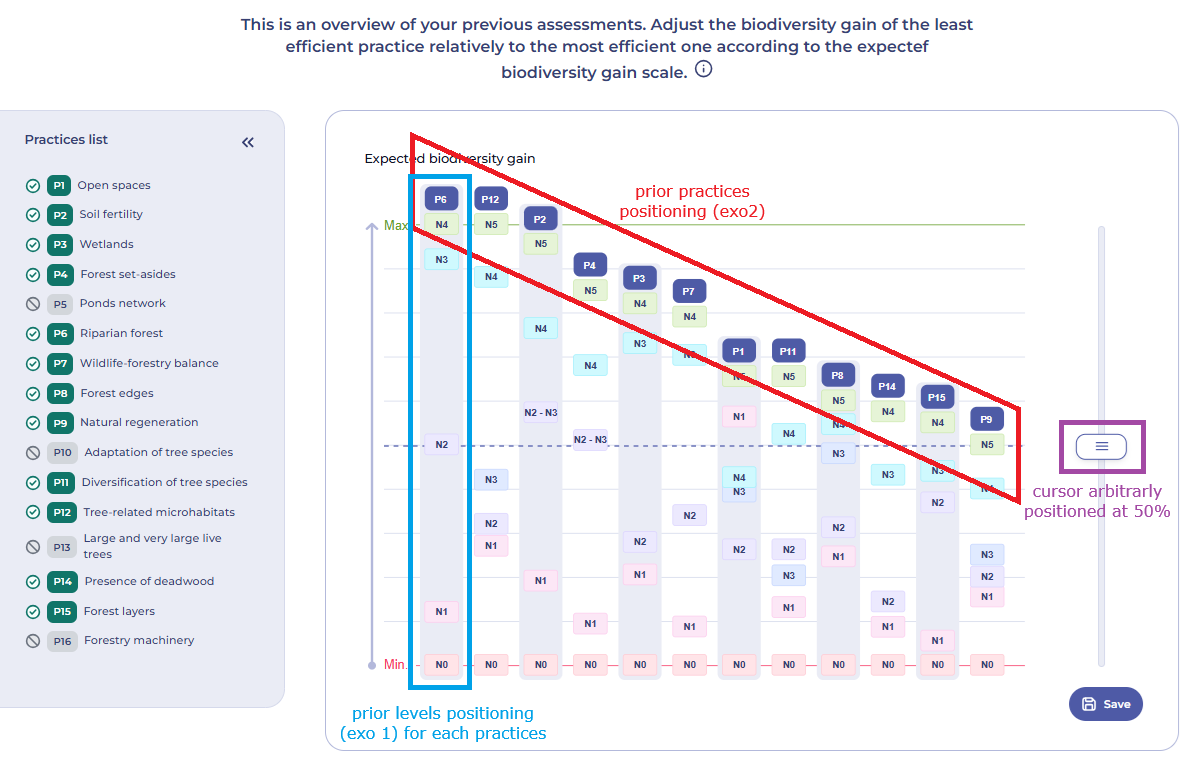
The cursor is to be positioned relatively to the entire display. Marginal adjustments are not possible, although you can readjust the values from exercise 1 by clicking on the practice in the menu.
With the exercise 1 and 2 results
Possible final positioning (1)
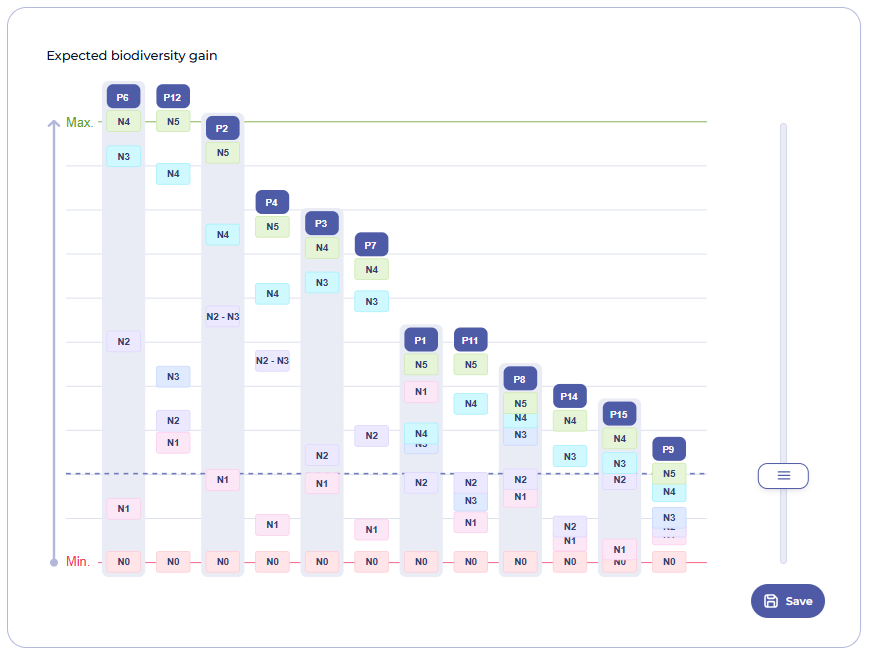
Possible final positioning (2)
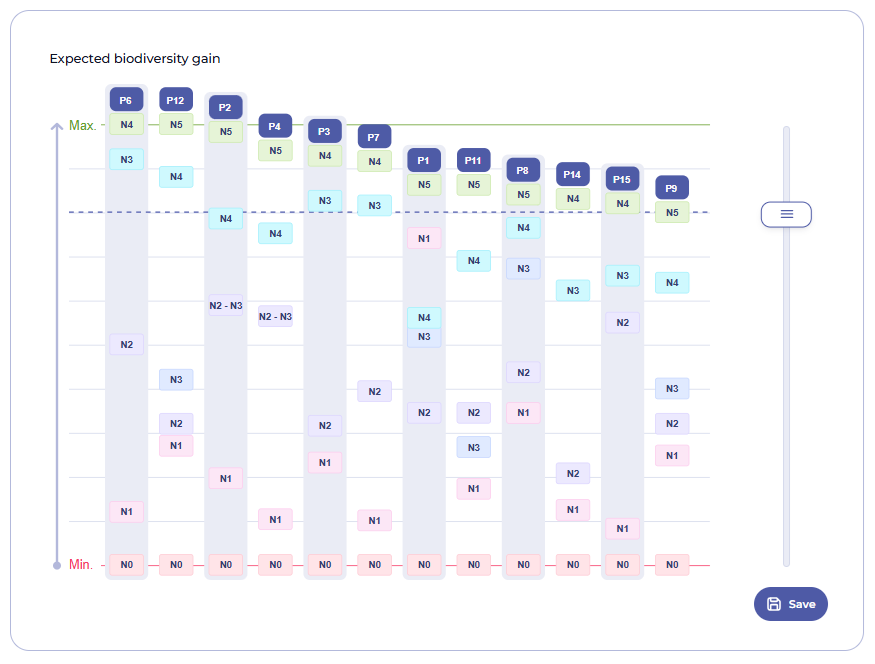
Once you are satisfied with your cursor position, please click on the "finish" button at the bottom of your screen, next to the progress bar. This action allows us to consider your assessment complete. This will not prevent you from coming back to modify it, if necessary, until the end of the campaign.
Indiquer que vous avez terminé
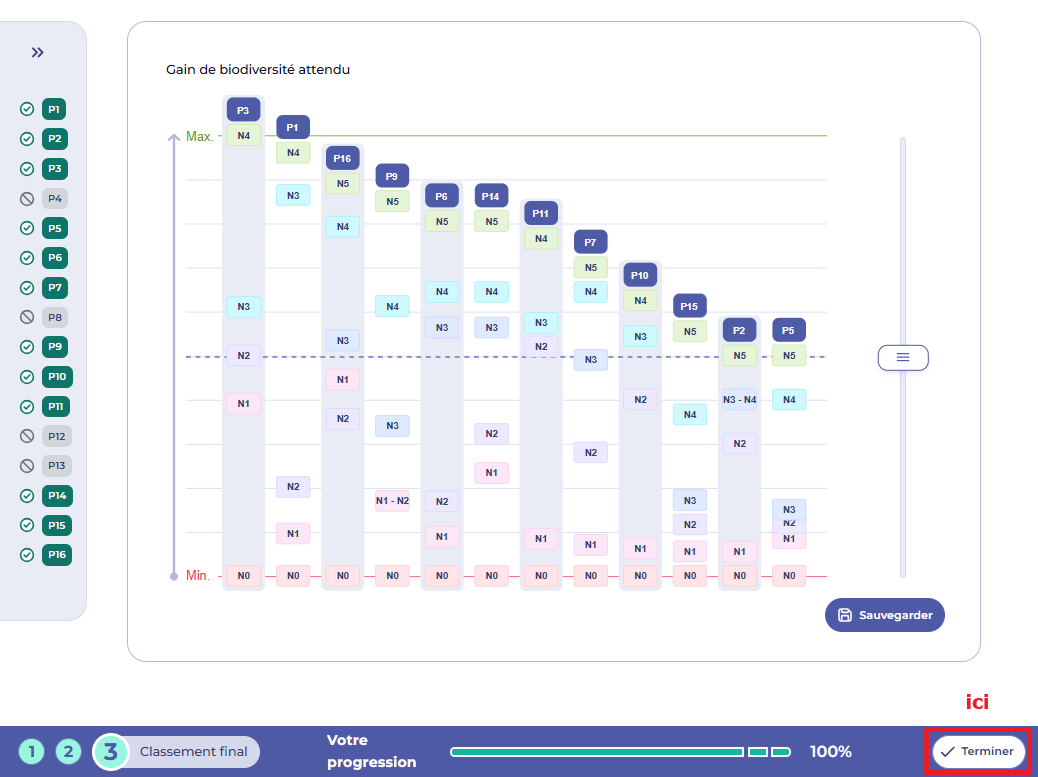
Cliquer sur "terminer" ouvrira une fenêtre de dialogue (qui n'apparait qu'au clic sur ce bouton). Elle vous permettra de nous indiquer si vous souhaitez être remercié nommément lors de la publication de nos résultats. Ces remerciements prendront la forme d'une liste et seront, bien sûr, décorélé des participations individuelles.
Consentir a être cité nommément dans les résultats
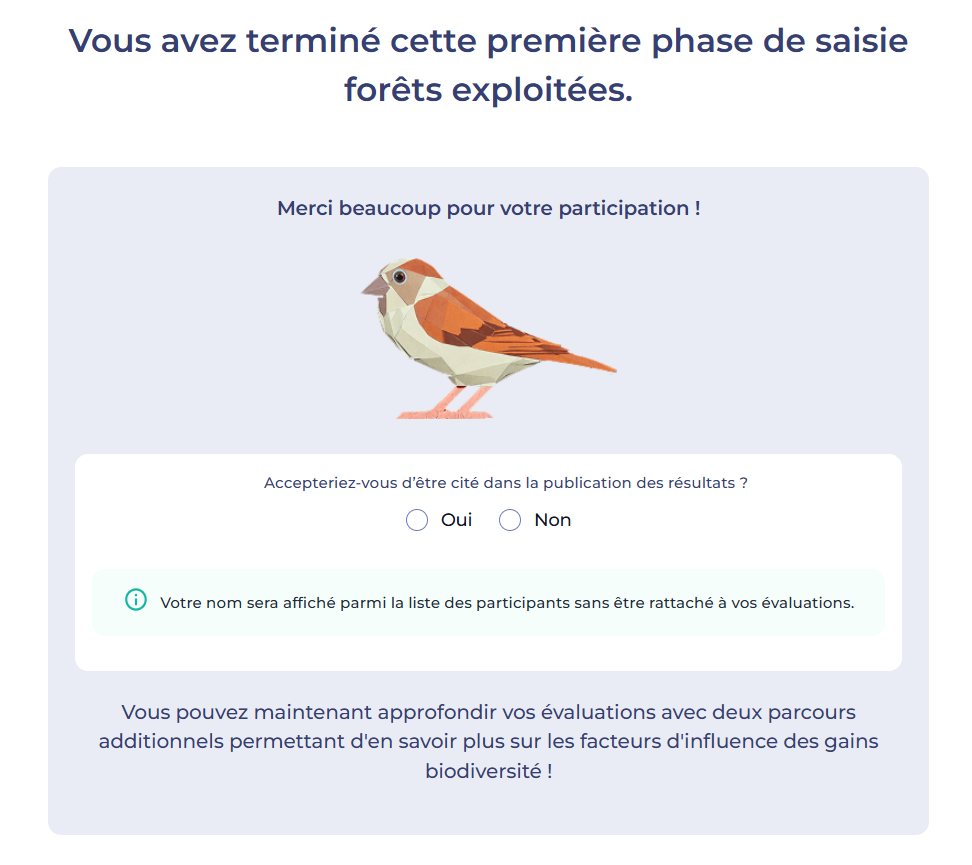
Parcours additionnels
Les parcours additionnels ne sont pas obligatoires et peuvent n'être remplis que partiellement. Ils sont, cependant, une véritable valeur ajoutée de la méthode. En effet, ils permettent d'appréhender des combinaisons de pratiques et de milieux d'implantation qui demanderaient des plans d'expériences trop complexes pour de la mesure in vivo. D'autant plus, lorsque l'on prend en compte les aléas contingents à la mesure du vivant sur le terrain.
Présentation

Les parcours additionnels ne sont accessibles qu'une fois le classement du parcours obligatoire (étape 1, 2 et 3, détaillées ci-dessus) réalisé. Ces parcours ne sont pas ordonnés, vous pouvez commencer par celui de votre choix et les remplir dans le désordre.
Exercice additionnel : Interactions entre pratiques
Lorsqu'une pratique est mise en œuvre, son gain attendu peut être amélioré ou réduit par la présence d'une autre pratique.
On souhaite mettre en œuvre des pratiques (blocs mobiles) à proximité d’une pratique à l’étude (titre fenêtre). Catégorisez l’effet de la pratique à l’étude sur le gain de la pratique mise en œuvre.
Affichage exercice interactions entre pratiques
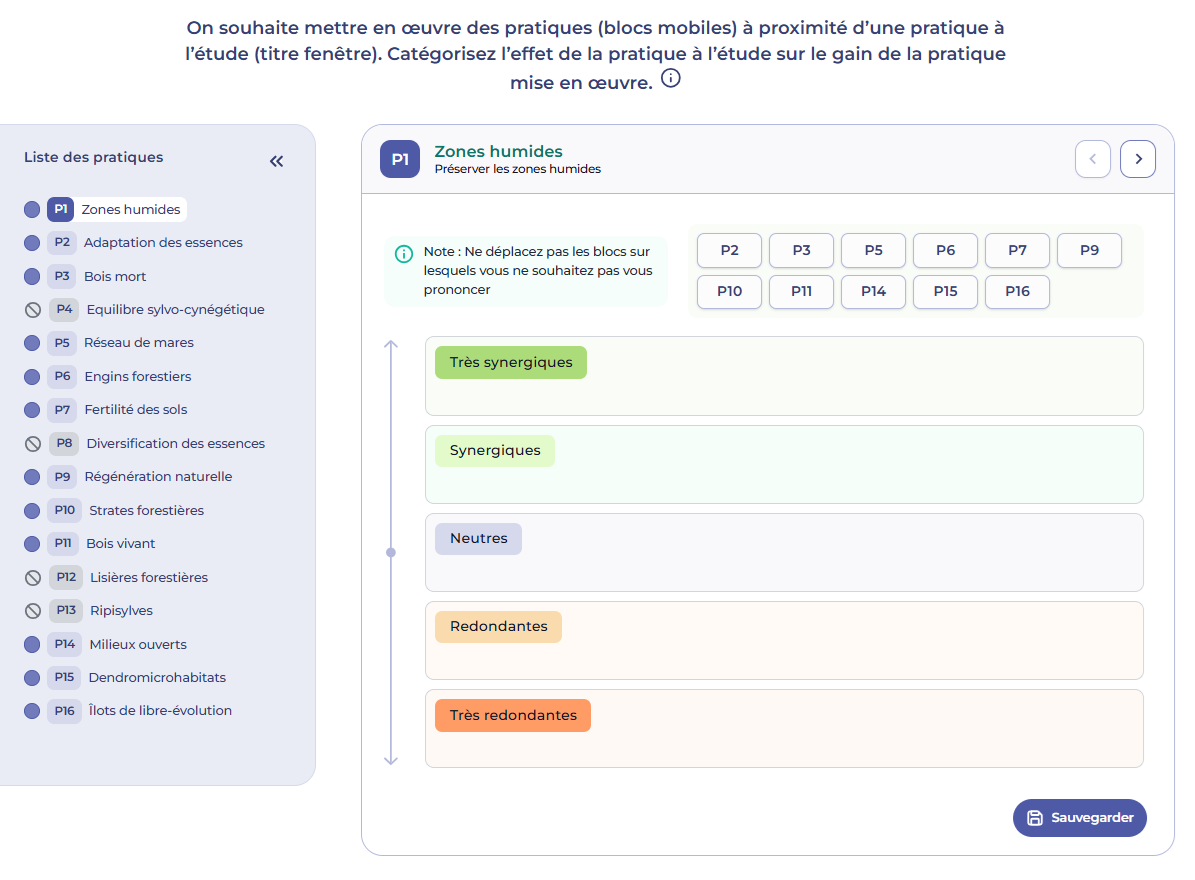
A gauche, le menu des pratiques qui permet de naviguer entre les pratiques pour renseigner celles de son choix. En titre de la fenêtre, la pratique à l'étude, considérée comme présente dans le milieu. En haut de la fenêtre, les blocs mobiles représentants les autres pratiques, à déplacer dans les cases correspondantes. On catégorise la relation envisagée lors de la mise en oeuvre de la pratique indiquée dans le bloc à proximité de la pratique en titre de la fenêtre. Sont exclues celles que l'évaluateur(ice) aurait jugé comme hors de son champ de compétence.
Catégorisation finale possible avec P1 (titre de la fenêtre, non visible ici)
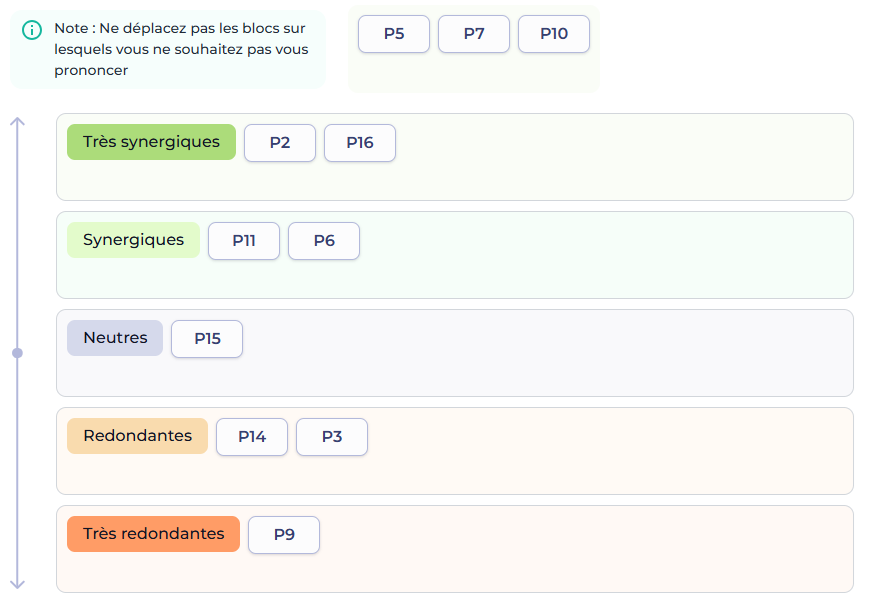
Afin de faciliter la tache de l'évaluateur(ice) nous suggérons des relations de symmétrie. Si le couple P1 ➜ P2 a été renseigné comme "très synergiques" (P1 titre de la fenêtre) alors lors de l'évaluation de P2 on propose d'emblée que P2 ➜ P1 soit "très synergiques" en plaçant le bloc P1 dans la case correspondante. Le bloc reste mobile mais les pratiques se remplissent ainsi au fur et à mesure de l'expérience. Les blocs non déplacés représentent les relations qu'on ne sait pas qualifier.
Cet exercice permettra d'adapter les gains de biodiversité attendu par un projet multipratiques, de prendre en compte l'existant et d'encourager des projets composés de pratiques qui se portent bénéfices.
Exercice additionnel : Effet du milieu d'implantation
Catégorisez les effets des caractéristiques du milieu d'implantation sur le gain de biodiversité attendu par les pratiques.
Lorsque la pratique sélectionnée est mise en place, quel est l’effet des trois caractéristiques du milieu d’implantation, sur le gain de biodiversité attendu ?
Affichage de l'écran de l'exercice
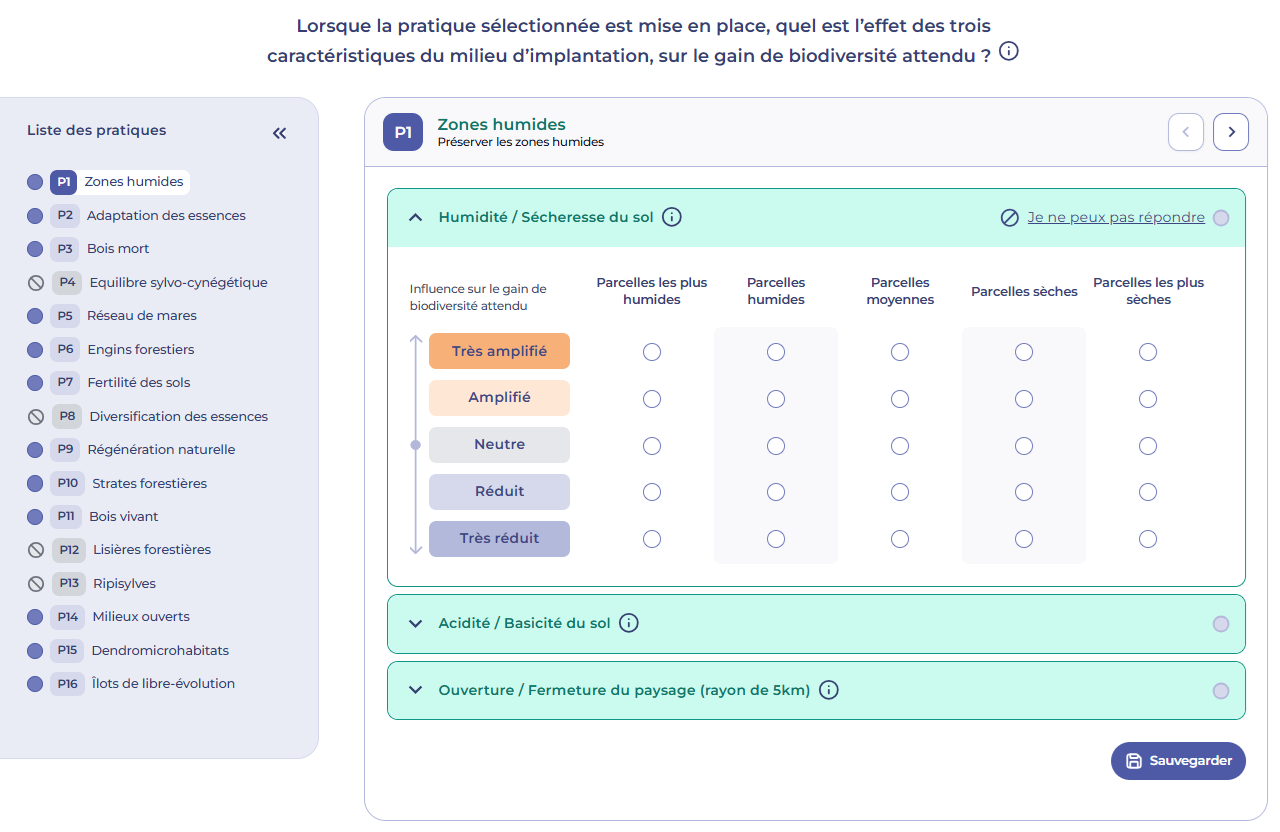
A gauche, le menu des pratiques qui permet de naviguer entre les pratiques pour renseigner celles de son choix. En titre de la fenêtre, la pratique à l'étude considérée comme présente dans le milieu. On demande de renseigner l'effet de conditions pedo-climatique / physico-chimique / paysagère sur la réalisation du gain de la pratique étudiée. Nous sommes conscient(e)s que humidité, acidité et ouverture du paysage ne sont pas exhaustifs pour décrire un milieu. Ils nous permettent de couvrir différents aspects pour tester le mode de recueil et l'effet sur le calcul du gain.
Il faut considérer le gradient de répartition des parcelles sur l'ensemble du socio-écosystême donné. Par exemple "parcelle les plus humides" ferait référence aux parcelles les plus humides parmis les forets exploitées en climat tempéré d'Europe occidentale.
Catégorisation finale possible
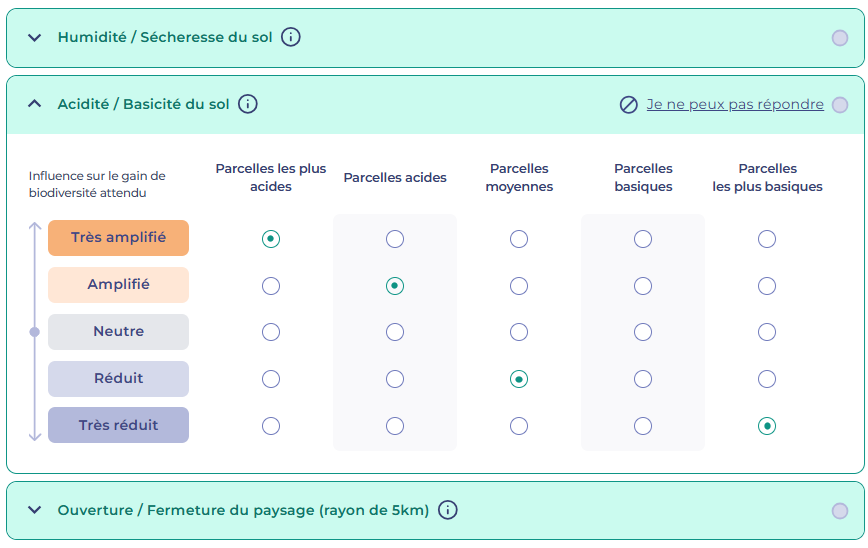
Il n'est pas nécessaire de tout renseigner pour qu'une participation soit prise en compte.
Cet exercice permettra d'adapter les gains de biodiversité au milieu dans lequel le projet se réalise et d'encourager des projets qui bénéficient vraiment de leur milieu d'implantation ou de repenser des projets qui ne seraient pas adaptés à leurs milieux.

